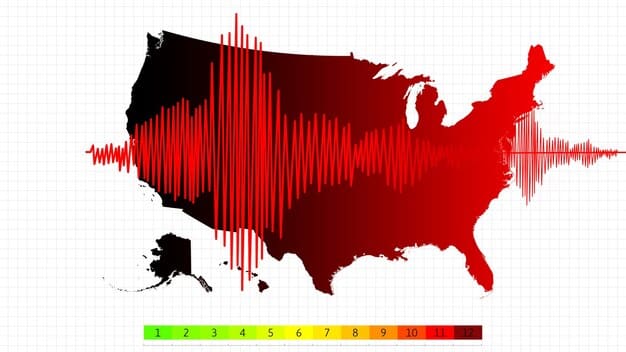Housing Market Trends: Impact of Rising Mortgage Rates on Home Sales

The current housing market is significantly influenced by rising mortgage rates, which impact home affordability and sales volumes, necessitating a dynamic adaptation from both buyers and sellers in the United States.
Understanding the intricate dynamics of the American housing market requires a keen eye on various economic indicators. One of the most influential factors currently shaping these dynamics is the phenomenon of Housing Market Trends: Analyzing the Impact of Rising Mortgage Rates on Home Sales. This article delves into how fluctuations in borrowing costs are reshaping the landscape for prospective homeowners and real estate professionals across the United States.
The Interplay of Mortgage Rates and Affordability
The housing market is a complex ecosystem, constantly reacting to a symphony of economic signals. Among these, mortgage rates stand out as a particularly potent determinant, directly influencing affordability and, by extension, home sales. When mortgage rates ascend, the cost of borrowing increases, meaning prospective homebuyers face higher monthly payments for the same loan amount. This direct correlation can significantly diminish purchasing power and temper demand.
Understanding Mortgage Rate Movements
Mortgage rates do not operate in a vacuum; they are influenced by a confluence of factors, primarily the federal funds rate set by the Federal Reserve, inflation expectations, and the overall health of the economy. A hawkish stance from the Fed, often in response to stubbornly high inflation, translates into higher short-term rates, which then ripple through to long-term rates like mortgages.
- Federal Reserve Policy: The Fed’s decisions on interest rates are a cornerstone, impacting the broader financial market.
- Inflationary Pressures: Lenders anticipate inflation and factor it into their rates to preserve the real value of their returns.
- Economic Growth: A robust economy might see higher rates as demand for capital increases.
- Global Events: Geopolitical shifts and global economic uncertainties can also influence bond markets, which in turn affect mortgage rates.
The Erosion of Purchasing Power
A seemingly small increase in a mortgage rate can translate into a substantial rise in monthly payments over the life of a loan. For instance, a half-percentage point rise on a $400,000 mortgage can add hundreds of dollars to a monthly payment. This additional burden can push aspiring homeowners out of their target price range or simply out of the market entirely. The result is often a slowdown in transaction volumes, as fewer buyers qualify or fewer homes become affordable. This erosion of purchasing power is not just theoretical; it’s a lived reality for many American families navigating the current economic climate, forcing difficult trade-offs and adjustments in their homeownership aspirations.
Ultimately, the delicate balance between supply and demand in the housing market is heavily tipped by the affordability factor. As mortgage rates continue to be a central talking point in economic discussions, their impact will remain a crucial consideration for anyone looking to buy or sell property. The market adapts, but often with a lag, and the current adjustments reflect a nuanced response to evolving borrowing costs.
Impact on Home Sales Volume and Pace
The ripple effect of rising mortgage rates extends far beyond just affordability; it significantly influences the volume and pace of home sales. When borrowing costs increase, the pool of eligible buyers shrinks, and those who remain become more cautious, leading to a noticeable deceleration in market activity. This section explores how these rates affect the number of transactions and the speed at which properties change hands.
Slowing Down the Market: Fewer Transactions
A direct consequence of higher mortgage rates is a reduction in the total number of homes sold. Potential buyers, facing higher monthly payments, either delay their purchase plans, look for less expensive homes, or withdraw from the market altogether. This reduction in demand can lead to a backlog of inventory, especially in segments where homes were previously selling rapidly.
Consider a scenario where rates jump by one percentage point. This might eliminate a significant percentage of potential buyers who were pre-qualified at the lower rate, fundamentally changing the competitive dynamics of the market. The shift from a seller’s market to a more balanced, or even buyer’s market, often begins with a slowdown in transaction volumes as demand cools.
Days on Market: A New Reality
Another key indicator affected by rising rates is the “days on market” (DOM)—the time a property remains listed before going under contract. In a low-rate environment, homes often attract multiple offers quickly, leading to rapid sales and bidding wars. With higher rates, demand slackens, and buyers become more discerning. They have more time to evaluate properties, negotiate, and consider their options, leading to longer DOM. This extended period can increase holding costs for sellers and may necessitate price reductions to attract buyers.
The increased DOM reflects a fundamental shift in market power. Sellers who once dictated terms must now be more flexible, considering offers that might have been rejected outright in a more frenzied market. This change in pace affects everything from marketing strategies to listing prices, forcing a re-evaluation of expectations for all parties involved. A slower market, while challenging for some, also offers new opportunities for others, allowing for more thoughtful decision-making rather than impulsive purchases driven by urgency.
Geographic Disparities and Local Market Resilience
While the national trends in housing are often discussed broadly, the reality on the ground presents a mosaic of varying resilience and responsiveness across different geographic regions. The impact of rising mortgage rates is not uniform; local economic conditions, housing supply dynamics, and population shifts play crucial roles in determining how individual markets fare. Understanding these disparities is crucial for anyone looking to gauge the true state of the US housing market.

Resilient Hubs vs. Vulnerable Communities
Some metropolitan areas, particularly those with strong job markets, diverse industries, and persistent housing shortages, tend to exhibit greater resilience against the headwinds of higher mortgage rates. These “resilient hubs” might experience a slowdown in sales volume, but a significant dip in prices is less likely due to sustained demand and limited supply. Conversely, regions heavily reliant on specific industries, those with excess inventory, or areas experiencing population decline may be more vulnerable to market downturns. In these “vulnerable communities,” even moderate rate hikes can trigger more pronounced price corrections and prolonged periods of reduced sales activity.
For instance, tech-heavy cities like Seattle or Austin, despite some recent cooling, may show more long-term price stability compared to more speculative or less economically diverse locales. The underlying economic strength of a region acts as a buffer, helping to absorb some of the shock from higher borrowing costs. This highlights the importance of analyzing local economic fundamentals when assessing real estate prospects.
Supply, Demand, and Local Nuances
The existing housing supply plays a critical role in how local markets react. Areas with a chronic undersupply of homes are fundamentally different from those with ample inventory. In supply-constrained markets, even with higher rates, competition for the limited number of available homes can keep prices relatively firm. Conversely, markets with an oversupply might see prices drop more significantly as sellers become more desperate to offload properties.
- Inventory Levels: Low housing inventory helps to stabilize prices even amidst reduced demand due to high rates.
- Job Growth: Strong local job creation attracts new residents, sustaining housing demand.
- Migration Patterns: Influxes of new residents (e.g., from urban to suburban or vice-versa) can create localized demand pockets.
- Local Regulations: Zoning laws and building permits impact the speed and volume of new construction, influencing supply.
Furthermore, local regulations, property taxes, and regional development plans add layers of complexity. A new municipal regulation easing building restrictions, for example, could significantly alter the supply outlook for a specific city, differentiating its trajectory from a neighboring one with stricter rules. These local nuances make a blanket national analysis insufficient and underscore why real estate is, at its core, a local business.
Strategies for Buyers and Sellers in a Shifting Market
The current housing market, shaped by climbing mortgage rates, demands a strategic and agile approach from both buyers and sellers. The days of frenzied bidding wars and automatic appreciation may be behind us for now, replaced by a more considered environment where patience and well-informed decisions are paramount. Adapting to these new dynamics is key to success on either side of a transaction.
For Buyers: Prudence and Negotiation Power
For prospective buyers, the landscape offers both challenges and opportunities. While higher rates mean increased costs, they also bring less competition and more negotiation leverage. This is a market where thorough preparation and a clear understanding of financial limits are more crucial than ever.
- Re-evaluate Budgets: With higher rates, it’s essential to reassess what’s truly affordable. Focus on the monthly payment, not just the purchase price.
- Flexibility with Location: Consider broadening your search to include slightly less popular neighborhoods or areas with more inventory, which may offer better value.
- Don’t Be Afraid to Negotiate: Sellers are often more willing to negotiate on price, contingencies, or even offer credits for closing costs or rate buy-downs.
- Pre-Approval is Key: A solid pre-approval from a reputable lender strengthens your offer and signals seriousness to sellers.
Exploring adjustable-rate mortgages (ARMs) might be an option for some, but only after careful consideration of future payment risks. Focus on long-term sustainability rather than short-term savings that might erode in the future. This market rewards the patient and informed buyer.
For Sellers: Realistic Expectations and Strategic Adjustments
Sellers, too, must adjust their expectations from the peak market conditions. Pricing strategies, home presentation, and marketing efforts become more critical when buyer demand is tempered. Selling a home now requires a more strategic and less reactive approach.
Sellers must be realistic about pricing. Overpricing in a slowing market is a common mistake that leads to prolonged listing periods and eventual price reductions. It is often better to price competitively from the outset to attract attention. Furthermore, enhancing a home’s appeal through minor repairs or staging can make a significant difference. Buyers have more options and are pickier; a well-maintained and aesthetically pleasing home stands out. Being flexible with showings and open to negotiations, including potential buyer contingencies, also become valuable tactics. The goal is to make the home as attractive as possible in a market where buyers are less motivated by urgency.
The Role of Economic Indicators and Future Outlook
Predicting the precise trajectory of the housing market is akin to forecasting the weather – an educated guess based on current patterns and anticipated changes. However, by closely monitoring key economic indicators, we can form a more informed outlook on how rising mortgage rates might evolve and continue to shape home sales. These indicators serve as vital signposts, guiding our understanding of market health and potential future shifts.
Key Economic Barometers
Several macroeconomic factors collectively inform the direction of mortgage rates and the broader housing market. Inflation, for instance, is a primary driver. When inflation remains elevated, the Federal Reserve is more likely to maintain or raise its benchmark rates, which in turn influences mortgage rates. A cooling inflation rate, conversely, could prompt the Fed to ease its stance, potentially leading to lower mortgage rates.
Beyond inflation, employment figures are critical. Strong job growth typically signals a healthy economy, which can support housing demand despite higher rates. However, if job growth falters, it could signal economic contraction, further dampening housing activity. Consumer confidence, supply chain health, and global economic stability also play pivotal roles. A confident consumer is more likely to make large purchases like a home, while stable supply chains can alleviate construction costs and improve inventory.
Anticipating Future Trends
The future outlook for housing markets depends heavily on the Federal Reserve’s long-term strategy for managing inflation and fostering economic stability. Should inflation begin to recede more definitively, there’s a possibility of mortgage rates stabilizing or even declining modestly. However, sustained high inflation or unexpected economic downturns could keep rates elevated, continuing to exert pressure on affordability and sales.
- Inflation Trajectory: A primary driver of Fed policy and, consequently, mortgage rates.
- Federal Reserve’s Stance: Their commentary and actions provide strong clues about future rate movements.
- Housing Inventory: Persistent low inventory in many regions will continue to underpin prices even with slowed demand.
- Demographic Shifts: Millennial and Gen Z buyers entering the market will provide long-term demand support.
It is also important to consider the underlying demographic trends. Young cohorts entering prime home-buying age will continue to represent a significant source of demand over the long term, offsetting some of the immediate challenges posed by high rates. However, their ability to enter the market will remain contingent on affordability, which underscores the central role of mortgage rates in their homeownership journey. Therefore, while short-term volatility is likely, long-term trends suggest a market that will eventually find its equilibrium, albeit at potentially different price points and sales volumes than pre-pandemic highs.
Emerging Housing Market Adjustments and Innovations
As the housing market continues to navigate the impact of rising mortgage rates, it’s not simply undergoing a slowdown; it’s actively adjusting and, in some cases, innovating to meet new challenging circumstances. These adaptations range from shifts in buyer behavior to evolving financing options and new construction strategies, all designed to find equilibrium in a less affordable environment. This dynamic evolution is key to maintaining market functionality and accessibility.
Adapting to a Buyer-Skeptical Environment
One significant adjustment is the re-emergence of buyer caution. The “fear of missing out” (FOMO) that characterized the recent boom market has largely dissipated. Buyers are now more analytical, taking longer to make decisions and scrutinizing properties more thoroughly. This means sellers are increasingly offering incentives that were rare just a couple of years ago, such as:
- Price Reductions: More frequent and deeper cuts to asking prices as properties sit longer.
- Seller Concessions: Offering to cover a portion of closing costs or provide credits for repairs.
- Rate Buy-Downs: Contributing funds to “buy down” the buyer’s mortgage interest rate for the first few years.
- Home Warranty Programs: Providing peace of mind to buyers regarding potential future repairs.
These concessions reflect a pragmatic shift from sellers, acknowledging the affordability crunch faced by buyers. They represent a willingness to absorb some of the financial burden to facilitate a sale, rather than holding out for peak-market prices that are no longer sustainable.
Innovative Financing and Construction Approaches
Beyond traditional mortgage structures, the market is seeing a renewed interest in, and evolution of, alternative financing options. Adjustable-rate mortgages (ARMs), while inherently riskier, are gaining traction among buyers who are confident rates will fall in the coming years and plan for refinancing. Furthermore, builders are adapting their strategies by focusing on smaller, more affordable homes or offering incentives directly rather than relying solely on price drops.
The long-term impact of these adjustments will likely be a more balanced market, where sensible pricing meets realistic buyer capacities. While the era of ultra-low rates may be behind us for a while, the market’s capacity for adaptation through incentives, flexible financing, and thoughtful construction strategies ensures its continued, albeit slower, activity.

| Key Point | Brief Description |
|---|---|
| 📊 Mortgage Rate Impact | Rising rates directly reduce home affordability and purchasing power for buyers. |
| धीमी Sales Volume | Higher rates lead to fewer home sales and longer days on market for properties. |
| 📍 Geographic Disparities | Impact varies significantly by local market strength, inventory, and economic health. |
| 💡 Market Adjustments | Buyers gain negotiation power; sellers offer incentives like rate buy-downs. |
Frequently Asked Questions About the Housing Market
Rising mortgage rates disproportionately affect first-time homebuyers by increasing their monthly payments, making it harder to qualify for loans. This often means they have to lower their budget, delay their purchase, or look for homes in less expensive areas, impacting their entry into the housing market.
While higher rates can cool demand and slow price growth, significant widespread decreases are less certain. Prices might stagnate or see modest declines in some areas, especially those with ample supply. However, strong job markets and continued low inventory in desirable locations could prevent sharp drops nationally.
Sellers can adapt by pricing competitively, improving home presentation, and being open to negotiations. Offering seller concessions, such as covering closing costs or providing a temporary rate buy-down for the buyer, can also make a property more attractive and facilitate a quicker sale in a challenging market.
The duration of high mortgage rates depends on several factors, primarily inflation and Federal Reserve policy. If inflation cools consistently, the Fed may consider lowering its benchmark rates, which could lead to a decrease in mortgage rates. However, economic forecasts are dynamic and subject to change.
The decision to buy is highly personal. While current rates increase borrowing costs, they also lead to less competition and more negotiation power for buyers. If you plan to stay in the home long-term and can comfortably afford the payments, buying now could still be a good investment, especially if you anticipate future refinancing options.
Conclusion
The housing market in the United States continues to evolve under the significant influence of rising mortgage rates. These rates have reshaped affordability, slowed sales volumes, and introduced a more cautious dynamic for both buyers and sellers. While challenges persist, the market is demonstrating its capacity for adjustment through various strategies, from seller concessions to changing buyer expectations. Navigating this landscape successfully requires an informed perspective, an adaptive mindset, and a deep understanding of local market nuances. As economic indicators continue to shift, staying attuned to these trends will be paramount for anyone engaged with the American real estate sector.





